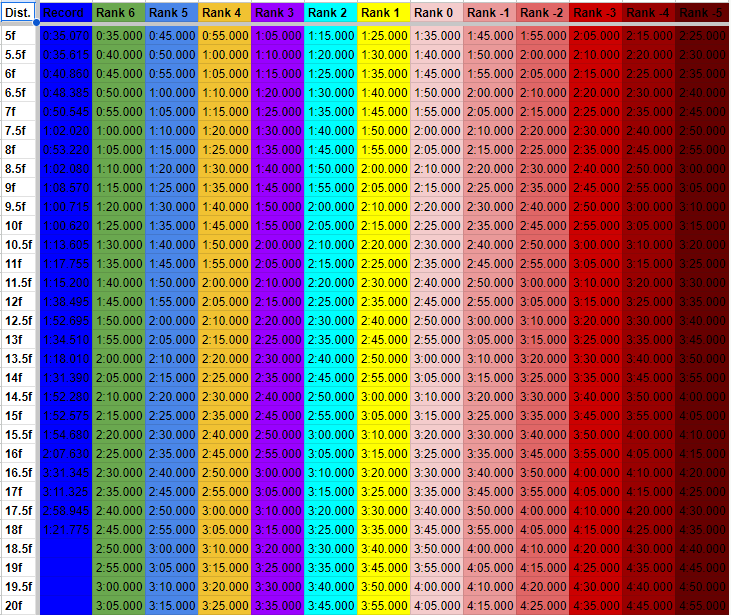A bit late to the conversation but figured I’d chime in anyway. I’ve been around (technically) since about 2008 (FF year 2012), first as Hokkaido Stables (I left for a time during college but couldn’t stay away) and then now as Sakura Springs, and I only stud qualified my first stallion a couple years ago. A look at some of my best stallions & mares:
- Final Scene was purchased for $30k at 3 years old.
- Powerful Soul was $75k at 2 years old.
- Quirky Scent was a steal, bought from FF for $10k at 3 years old. I think he might have been a claimer.
- My all-time best stallion, Tense Imagination, was purchased at 3 years old for $16k.
- My mare Aria was a homebred. Her dam, Notos, was bronze-ranked when I sold her off. Aria was a late bloomer. She got her first win at 4 and her first stakes win at 5.
- Towering Clover was a 2YO I won from the Color Wars back in the day. (I actually really miss those).
- Fractal was also a homebred. At the time she was born, her sire was bronze-ranked and her dam was unranked. Her dam, Limelight, was the first foal born in my stable back when I joined as Hokkaido Stables, and I purchased her for her claim price of $30k.
All of this to say, the cost of a horse doesn’t necessarily determine its worth. I have my highs and lows. This year has not been my best year, although part of that has to do with the fact that IRL life has kicked me in the seat of my pants and I just don’t have as much time or energy to devote to the game as I would like. Because to be really, truly successful, it does require some effort. Still, there are ways to make it easier on yourself.
For me, I do some of what has been mentioned above. I really got going by purchasing horses from more successful stables and checking their training patterns. It helped me get a foothold on a part of the game I simply couldn’t understand. There’s no one tried-and-true training method that works for all horses every time, but it can at least give you a baseline.
For racing a horse, I typically only race them once a month and ship them home for 2 weeks after every 2-3 races or months (whichever comes first). Overkill? Maybe. But I usually see a boost in overall performance when I run them this way.
I have also developed a ton (and I do mean a ton) of data analysis sheets to work off of over the years. The things I have found most helpful to track are what I call their success percentiles and their time scores.
I calculate a horse’s success percentile by dividing their place in a race by how many horses ran alongside them. A win in a field of 5 isn’t as impressive as a win in a field of 14. The lower the overall percentage, the better a horse does, and I’ve found that trend to be relatively consistent. I track those percentiles in several different ways: overall performance, performance by racing year, and performance by track. Most stud-qualified stallions land in the 42% range for overall performance, and I get most of my top-three placings at or below 25%. That’s usually how I judge whether or not to enter a horse in a stakes race.
On top of that, I’ve developed a sheet of “time scores” to compare a horse’s running time to those of other horses based on distance. (I should note that I have not tested this on SC horses. I only run flat.) I really love Final Furlong and it has saddened me to see so many people dropping out because of lack of success, so I’m going to post a screenshot of my time score sheet here in case it might be helpful.
Sometimes, a horse can bomb a race (or even two or three), but when I look at the time scores, they are still running well. When I first created this method of judging a horse’s success, I was almost guaranteed a win at the Level 3 mark (the purple column). Many horses now are getting their wins at 4, 5, and 6. There have been races where I’ve had a horse run 5th even with a score of 4. Horses that have been chilling for half a year are most likely to fall into that category.
There’s a lot more that goes into my strategy than that, but those methods of tracking a horse’s success have made a huge difference in my team’s overall performance. In FF year 2020, my OTB was 16%. The next year was when I began developing these methods, and it bumped to 37%. Last year, my OTB was 61% out of 393 races.
All of this to say, I hope you don’t give up. It takes some work, but if you’re up for the challenge, it is entirely possible to be successful and at least stay competitive in this game. Wishing you all the best!
Edit: I forgot to mention one thing about the time scores. 2YOs almost never score higher than a 2. By nature they run slower. A good winning score for a 2YO is between 0 and 1.
